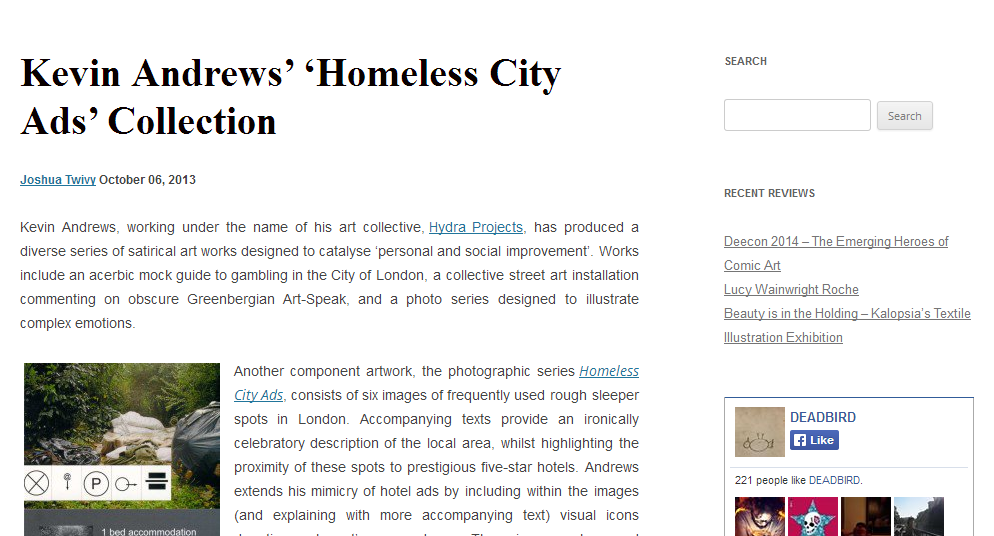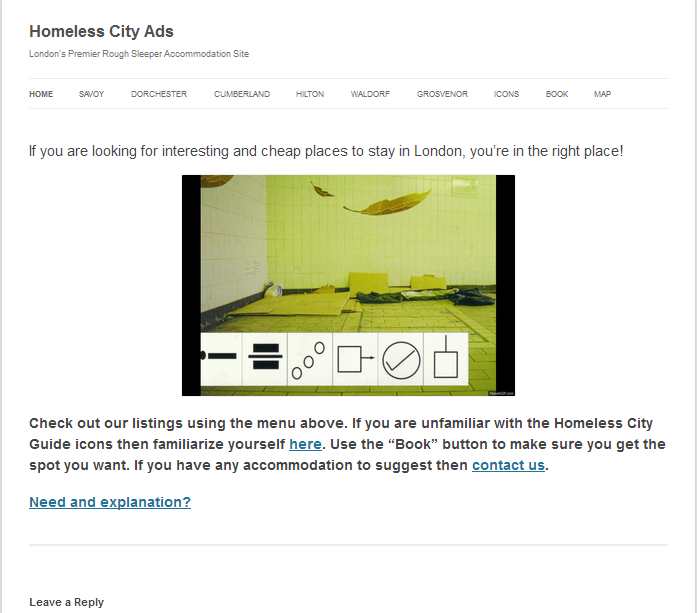Homeless City Ads selected for the Photo and Print OpenSalon 2013 Charlie Dutton Gallery
A photograph of a well-known rough sleeper spot under Waterloo Bridge, one of a series of
six, has been selected as one of the works to be shown as part of the Photo and Print Open
Salon 2013 at the Charlie Dutton Gallery in London’s Holborn. The photo which mixes the
image of a rough sleeper place at the edge of the Thames with a series of icons from the
Homeless City Guide was taken by art group Hydra Projects.
Kevin Andrews one of the founders of Hydra Projects said “the photo was edited to look like
a picture from an accommodation listing website like Gumtree or Where to Sleep. A
description was then added drawn from the publicity material for the nearby Savoy Hotel”.
The photo is an attempt to point to the irony of the close location of rough sleeper places
and five star hotels. Andrews continues “it’s the kind of thing we take for granted in modern
cities because we have become numb to it. The photograph tries to question that
numbness.”
The text accompanying the photo states:
“2 bed accommodation near the Savoy Hotel, London
Underneath the iconic Waterloo Bridge and sharing the same views as the landmark Savoy
Hotel this accommodation has an enviable location on the River Thames. The spot is literally
steps away from some of the world’s finest theatres, museums and opera houses. Its
proximity to the City means you will be ideally placed whether you are in London for business
or pleasure or both.”
The icons that appear on the photograph are drawn from the Homeless City Guide. From
left to right they read:
- A good place to sleep
- Good food is thrown away here
- Potential for work
- Message board near here
- Friendly place
- Good place to drink and smoke
This Homeless City Guide is a regular feature of the magazine Pavement. This is a language
invented for homeless people. The idea being that they use it to communicate with one
another about features of the city. The icons were designed by Emily Read and Chen Hsu in
2007. Their work is described as a modern day version of the centuries old language of the
Hobo Code, as they say “The homeless can use this series of simple symbols to communicate
with each other about safety, shelter, and free food by inscribing them with chalk on
sidewalks, buildings, and other surfaces”. But according to Andrews the language is not
used. He says “this isn't very surprising; it’s based on a romantic notion of what
homelessness is”.
Asked whether the adverts posted on accommodation websites received many replies
Andrews says “Not really, they were never on long enough to attract that much attention”.
Somehow Gumtree and other sites were able to spot the ads quite quickly and remove them
and block me from posting more.” He says “I had more success with postcards that I made
up and placed at the locations, they all went very quickly and I think provide a lasting record
of the work”.
The photo was chosen from hundreds submitted to the Photo and Print Open Salon 2013 at
Charlie Dutton Gallery, now in its second year. This year’s selection panel featured John
Stezaker (known for his collages of Hollywood stars) and Gallerist and Collector Julia
Muggenburg (Belmacz) as well as Charlie Dutton and Kate Saffin of the Charlie Dutton
Gallery.



